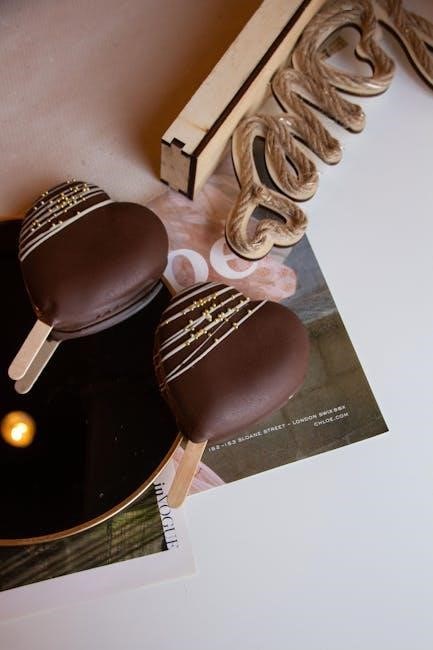Popsicle stick catapults offer a hands-on STEM activity, teaching kids about simple machines and physics․ Using craft sticks, rubber bands, and spoons, learners create a functional mini-catapult, exploring energy conversion and motion principles while fostering creativity and critical thinking․
Overview of the Project
This project involves designing and building a simple catapult using popsicle sticks, rubber bands, and a plastic spoon․ It introduces basic engineering and physics concepts, such as levers and energy transfer․ Participants stack and secure popsicle sticks to create a sturdy base, attach a launching arm, and test the catapult’s performance․ The activity encourages creativity, problem-solving, and hands-on learning, making it suitable for all ages and skill levels․
Importance of STEM Education
STEM education fosters critical thinking, creativity, and problem-solving skills through hands-on activities like building popsicle stick catapults․ These projects introduce fundamental physics and engineering concepts, such as simple machines and energy transfer․ By engaging students in interactive learning, STEM activities inspire curiosity, prepare them for future challenges, and encourage exploration of careers in science, technology, engineering, and mathematics, laying the groundwork for innovation and lifelong learning․

Materials Needed
The essential components include popsicle sticks, rubber bands, a plastic spoon, and mini marshmallows or small projectiles․ These simple, affordable materials make the project accessible for all ages․
Essential Components
The core materials required include 10-12 popsicle sticks, which form the catapult’s frame, and rubber bands to secure the structure and provide tension․ A plastic spoon serves as the launching arm, while mini marshmallows or small projectiles are used for testing․ These components are inexpensive, readily available, and perfect for constructing a functional mini-catapult․ Additional items like a bottle cap or sticky tack can enhance performance but are optional․
Optional Add-ons
Optional enhancements include a bottle cap or plastic spoon as a projectile holder, sticky tack for stability, and additional rubber bands for increased tension․ Experimenting with different projectiles like pom-poms, Styrofoam balls, or marshmallows adds variety to testing․ These additions can improve performance and customization, allowing users to refine their designs further while keeping the project fun and adaptable․

Basic Design and Construction
Begin by stacking popsicle sticks to form the base, securing them with rubber bands․ Attach a perpendicular stick to create the lever arm, forming the catapult’s core mechanism․
Step-by-Step Assembly Guide
Start by stacking 8-10 popsicle sticks and securing them with rubber bands at both ends․ Attach a single stick perpendicularly to create the lever arm․ Place a plastic spoon or bottle cap at the end of the arm to hold projectiles․ Reinforce the base with additional sticks for stability․ Wrap rubber bands around the lever to increase tension․ Your catapult is now ready for testing and launching small objects like marshmallows or pom-poms․
Understanding the Mechanics
A popsicle stick catapult operates on the principle of energy conversion, using potential energy stored in stretched rubber bands․ When released, this energy transforms into kinetic energy, propelling the projectile․ The design leverages a simple machine concept, with the popsicle sticks acting as levers and the fulcrum providing a pivot point․ This setup demonstrates basic physics principles, making it an engaging STEM learning tool for understanding motion and force dynamics․

Advanced Techniques for Better Performance
- Optimize the fulcrum position to maximize energy transfer and distance․
- Enhance the launching arm’s flexibility and strength for improved propulsion․
Optimizing the Fulcrum
The fulcrum’s position significantly impacts the catapult’s performance․ Experiment with different placements to balance stability and energy transfer․ A well-secured fulcrum using rubber bands ensures maximum efficiency, allowing the launching arm to propel projectiles farther․ Adjusting the fulcrum’s angle and tension can also enhance accuracy and distance, making it a crucial step in refining your design․
Enhancing the Launching Arm
To improve the launching arm’s performance, ensure it is securely attached and aligned․ Reinforce the arm with additional popsicle sticks or rubber bands for added strength․ Experiment with different materials, such as a plastic spoon, to create a more durable and efficient launching mechanism․ Proper tension and alignment can significantly enhance projectile distance and accuracy, making the catapult more effective․

Troubleshooting Common Issues
Common issues include weak tension or misalignment․ Ensure rubber bands are tightly secured and the launching arm is properly angled for consistent performance and better results․
Identifying Weak Points
Common weak points in popsicle stick catapults include loose rubber bands, misaligned sticks, and weak joints․ Check for gaps where sticks are secured and ensure tight rubber band tension․ If the launching arm bends or breaks easily, reinforce it with additional sticks or glue․ Weak fulcrum points can also reduce performance, so verify stability and adjust as needed for consistent results․
Solving Stability Problems
To address stability issues, ensure the base is sturdy by using multiple sticks secured tightly․ Reinforce weak points with additional rubber bands or glue․ If the catapult wobbles, add side supports or widen the base․ Tightening connections and aligning the fulcrum properly can also improve balance․ For optimal performance, test and adjust the structure to maintain stability during launches, ensuring consistent and accurate results․

The Science Behind the Catapult
A catapult converts potential energy into kinetic energy․ When the launching arm is pulled back, energy is stored․ Upon release, it transfers force to the projectile, demonstrating Newton’s laws of motion and the principles of simple machines in action․
Physics Principles Involved
A popsicle stick catapult demonstrates fundamental physics principles, including energy conversion and Newton’s laws․ Potential energy is stored when the arm is pulled back, converting to kinetic energy upon release․ Torque and leverage play roles in the design, with the fulcrum affecting distance․ Newton’s laws explain motion and force interactions, providing hands-on learning․
Energy Conversion Process
The popsicle stick catapult illustrates energy conversion from potential to kinetic․ Rubber bands store potential energy when pulled back, releasing it as kinetic energy to propel the projectile․ The design’s efficiency depends on the fulcrum and arm mechanics, demonstrating how stored energy translates into motion and distance, making it a practical example of energy transformation in simple machines․

Educational Value
Building popsicle stick catapults fosters STEM learning, teaching engineering, physics, and problem-solving skills through hands-on creativity and experimentation, inspiring curiosity and critical thinking in students of all ages․
Learning Opportunities
Building popsicle stick catapults provides hands-on experience with engineering and physics, encouraging students to explore principles like tension, motion, and energy conversion․ It fosters creativity, problem-solving, and teamwork while introducing basic mechanical concepts․ Students learn to design, test, and refine their creations, developing critical thinking and analytical skills through iterative experimentation and observation of cause-and-effect relationships in a fun, interactive way․
Developing Critical Thinking
Building popsicle stick catapults challenges students to analyze design flaws, test hypotheses, and refine their creations․ This process fosters critical thinking by encouraging problem-solving, experimentation, and iterative improvement․ Students learn to evaluate performance, adjust variables, and understand cause-and-effect relationships, developing analytical skills essential for STEM fields and real-world problem-solving scenarios․
Creative Variations
Customize your catapult by experimenting with different materials, such as plastic spoons, bottle caps, or various projectiles like marshmallows or pom-poms․ Explore innovative designs to enhance performance․
Customizing Your Design
Experiment with various materials like jumbo popsicle sticks, rubber bands, and plastic spoons to create unique designs․ Add features such as supports or decorative elements to enhance functionality and aesthetics․ Try alternative projectiles like marshmallows or pom-poms for different launching effects․ Customize the fulcrum or arm length to optimize performance․ These modifications allow for personalized creativity while understanding the physics of tension, balance, and energy transfer in your catapult design․
Alternative Projectile Ideas
Explore creative projectiles like marshmallows, pom-poms, or cotton balls for a fun twist․ Experiment with lightweight materials such as Styrofoam balls or crumpled paper․ For a challenge, try launching small toys or beads․ Avoid using sharp or heavy objects for safety․ These alternatives allow you to test different launch dynamics while keeping the activity engaging and educational, making it perfect for STEM-based play and learning․

Detailed Step-by-Step Guide
Begin by stacking and securing popsicle sticks to form the base․ Attach the launching arm using rubber bands and a plastic spoon․ Test with small projectiles like marshmallows or pom-poms, ensuring safety and accuracy in each launch․ Follow the instructions carefully to assemble and optimize your catapult for maximum performance․
Preparing the Components
Gather 10-12 popsicle sticks, rubber bands, a plastic spoon, and optional glue․ Sort sticks by size and straightness for consistency․ Measure and cut sticks if needed for specific roles (base, arm, or supports)․ Ensure the plastic spoon is clean and ready to attach as the projectile holder․ Securely organize components to avoid misplacement during assembly, ensuring all materials are ready for the construction phase․
Assembling the Catapult
Begin by stacking 8-10 popsicle sticks and securing them with rubber bands at both ends, forming the base․ Attach a single stick perpendicularly to create the fulcrum․ Connect the launching arm using additional sticks and rubber bands․ Attach the plastic spoon to the arm to hold projectiles․ Ensure all connections are tight for stability and proper function, allowing the catapult to effectively launch small objects like marshmallows or pom-poms․

Tips for Maximum Performance
Adjust the fulcrum position for optimal balance and energy transfer․ Ensure rubber bands are tightly secured but not overstrained․ Experiment with projectile weight and arm tension to maximize range and accuracy․
Adjusting Tension
Properly adjusting the tension in your catapult is crucial for optimal performance․ Tighten rubber bands firmly to store potential energy, but avoid over-tightening, which can cause breakage․ Experiment with different levels of tension to achieve the desired launch distance and accuracy․ Ensuring the right balance between flexibility and rigidity will maximize your catapult’s efficiency and reliability․
Testing and Refining
After assembling your catapult, conduct thorough testing to evaluate its performance․ Launch projectiles like marshmallows or pom-poms to measure distance and accuracy․ Analyze the results and identify areas for improvement, such as adjusting the fulcrum position or tightening rubber bands․ Refining your design through iterative testing enhances functionality and ensures your catapult achieves its maximum potential efficiency and effectiveness․

Safety Precautions
Always handle materials carefully to avoid injuries․ Ensure the launching area is clear of people and breakable objects․ Adult supervision is recommended for young builders․ Use soft projectiles like marshmallows or pom-poms to minimize potential damage․
Handling Materials Safely
Always wear safety goggles when testing the catapult․ Handle sharp objects like scissors or craft knives with care․ Store small components like rubber bands and projectiles securely to avoid choking hazards․ Use soft, lightweight projectiles to minimize potential damage or injury․ Ensure the work area is clear and clean to prevent accidents․ Adult supervision is recommended when handling materials, especially for younger participants․
Operating the Catapult Responsibly
Operate the catapult in open spaces to prevent damage to objects or injury․ Always aim away from people and pets․ Avoid using sharp or heavy projectiles․ Ensure the area is clear before launching․ Test the catapult gently at first to gauge its strength․ Never leave the catapult unattended, especially around young children․ Follow all safety guidelines to ensure a fun and responsible experience․
